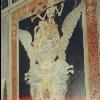
Cafe Cordina, Triq ir Repubblika

A few steps from Cafe Cordina
The rumours proved to be true! I spent 3 (or was it four?) days in Valetta, spending most of my time dealing with the two boats, but found also time to wandering in the city, travelling to nearby places and visiting Medina (or Mdina) as well. Exciting, really exciting!
Whoever knows something about the Arab world, may guess that the name of Medina is of Arab origin. Yes, Arab occupation was part of the history of Malta, a long chain of occupations. The history of this archipelago of 5 islands goes back to around 5000 B.C., when the first settlers appeared - most probably from Sicily - on Malta. The remnants of temples and cemeteries of the first millenniums are rare examples of rich architecture of early periods. Two other waves of newcomers is recorded before the firs occupants, the Phoenicians stepped on the soil of the islands, followed by Carthaginians. After the defeat of them in Pun Wars, Romans occupied their place. The Roman period was a flourishing one, the harbours were developed, industry and irrigation gave boost to the production of textiles and agricultural products like honey and olive. An interesting episode is on records that happened in 60 A.C.: the ship on which apostle Paul was carried as a captive to Rome, broke down at the shores of Malta. He was saved and spent three month preaching with enthusiasm, laying the foundations of Christianity. Not much is known of the era between the end of Roman occupation and the appearance of Islam, except probably that the fortification of the country continued during the Byzantine era. Even so it was not strong enough to resist the Arab invasion: Malta was defeated in 870. Arabs remained there for two centuries, leaving very deep impact: the language of Malta is basically Arab, enriched by the languages of later invaders; Mdina (Medina), the capital of the country for centuries was shaped by them and the main agricultural produce, the citruses were introduced during this period. Arabs were followed by Norman, Swabian, French, Aragonese invaders. The situation stabilized for some time when the islands became a part of the Sicilian kingdom of the Spanish Empire. We arrived now to the most widely known period of Malta's history: it was given as a gift (!) by the Emperor of Spain to the Knights of the Order of St. John in 1530. It would be too long a story to describe this Order, the role of Grand Masters, the way they ruled over the country. One of their outstanding achievement was that they selected Valletta for the new capital and fortified it, building the Fort, one of the mightiests in Europe. Their rule lasted till 1798, when Napoleon, then 29 years old landed on Malta and "requested" the Knights to leave the country, which they did. The French occupation lasted two years, when the Maltese rebelled, asked England to protect them, what the English readily agreed to do, declaring Malta - after their victory - dominion of England, which status continued till 1947, when the country was given self-government in the framework of Commonwealth, then independence in 1964. In spite of this the British military left the country only in 1979.
Why do I dwell so long upon the history? Because this variety of events has left deep marks on the country. Wherever you go, the impact of foreign cultures is felt. When Maltese speak on their mother-tongue, your impression is that you hear an Arabic dialect, the gestures are also close to what you see in the Arab world. But I have not seen a single mosque, the population is Catholic, the churches are Baroque.
It is simply amazing that this nation was able to preserve its basic character, survived all the calamities of this rude history and is now open towards others, optimistic, developing fast.
What I could visit during my short trip was more than interesting, it was exciting. Valletta alone is a treasure of unusual monuments, buildings and the Fort of it is exceptionally impressive. When you first arrive to the capital you cannot immediately perceive that it is a conglomerate of three or four cities, an island and old Valletta. I was staying for example in a hotel (booked by my hosts) situated in Sliema, the "living quarter" of which is Gzira, the office of my host-firm was in Msida, all the three are interweaved, the distances are just a few bus-steps, or half an hour walk. After the first meeting I had a few free hours before sunset, I took a bus and went to the old city, getting out at the "Bus Terminus", a busy, quite dirty square with veteran buses and small snack-bars around. The whole picture was very much Arabic.



In front of

Triq Iz Zekka (?)




Monument in front of



The gate to the garden of Parliament

The garden of the Parliament



The House of Parliament

Bus Terminus & Triton Fountain




The ruins of the Royal Opera House




Triq i Repubblika 1



Triq i Repubblika 2

Interior of St. John's Cathedral



St. John's Cathedral

Marble inlay in St. John's Cathedral



The view from my hotel


Msida Creek

Marina

Nem tanultam meg rendesen a szoftvert, ezért a megnyíló tablók alján lévő nyilakkal ne kísérletezzenek. Kattintsanak rá akármelyik fotóra (ha pop-up tiltó szoftver van a gépükön, egyidejűleg nyomják le a Ctrl billentyűt) és a megnyíló kép bal felső részén található vezérlő ikonokkal lapozzanak, illetve indítsák el a slideshow-t.
I have not learnt properly this software, therefore do not use the arrows on the platforms. Instead click on any of the photos (if you have pop-up blocker on your computer use simultaneously Ctrl as well) and manipulate further using the arrows that appear on the left upper side of the photo.
